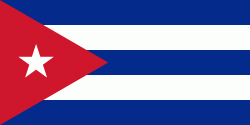Güines
 |
The city was founded in 1737 by the Spanish. Prior to the arrival of the Spanish, what is now Güines was part of a region ruled by the Indian chief Habaguanex.
One of the earliest mentions of the word Güines is in 1598, when Don Diego de Rivera or Ribera was awarded a land grant for Los Güines Corral.
Güines can be considered one of the primary points of Cuba's transformation into a sugar-producing slave society in the wake of the Haitian Revolution. Its demographics radically changed as a result. As the historian Ada Ferrer explains, "people classified as white had accounted for about three-quarters of the population in 1775" but "by the 1820s, they constituted less than 38 percent."
In 1837, a railway was opened from Havana - the first in Cuba and Spain, and one of the earliest in the Americas.
Map - Güines
Map
Country - Cuba
 |
 |
| Flag of Cuba | |
The territory that is now Cuba was inhabited by the Ciboney people from the 4th millennium BC with the Guanahatabey and Taíno peoples until Spanish colonization in the 15th century. From the 15th century, it was a colony of Spain, and slavery was abolished in 1886, remaining a Spanish colony until the Spanish–American War of 1898, when Cuba was occupied by the United States and gained independence in 1902. In 1940, Cuba implemented a new constitution, but mounting political unrest culminated in a coup in 1952 and the subsequent dictatorship of Fulgencio Batista, which was later overthrown in January 1959 by the 26th of July Movement during the Cuban Revolution, which afterwards established communist rule under the leadership of Fidel Castro. The country was a point of contention during the Cold War between the Soviet Union and the United States, and a nuclear war nearly broke out during the Cuban Missile Crisis of 1962. Following the collapse of the Soviet Union, Cuba faced a severe economic downturn in the 1990s, known as the Special Period. In 2008, Fidel Castro resigned after 49 years of leadership of Cuba and was replaced by his brother Raúl Castro.
Currency / Language
| ISO | Currency | Symbol | Significant figures |
|---|---|---|---|
| CUC | Cuban convertible peso | $ | 2 |
| CUP | Cuban peso | $ | 2 |
| ISO | Language |
|---|---|
| ES | Spanish language |















